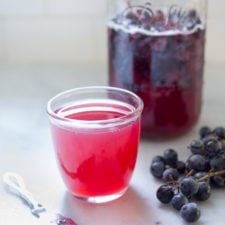How to make Water Kefir
4.9
(68)
Your folders
Your folders
Prep Time: 5 minutes
Cook Time: 72 hours
Total: 72 hours, 5 minutes
Servings: 8
Author : Sylvia Fountaine | Feasting at Home Blog

Ingredients
Export 7 ingredients for grocery delivery
Instructions
Step 1
Fill two, half-gallon mason jars with 4 cups cool tap water in each.
Step 2
Add ¼ cup sugar in each, stirring to mostly dissolve. ( Feel free to make sugar mixture first)
Step 3
Add ¼ cup kefir grains to each jar.
Step 4
Add ¼ kefir water to each jar (optional–you can obviously only do this after your first batch of kefir, so just leave it out for the first batch.)
Step 5
Add ¼ of a lemon wedge to each jar.
Step 6
Add 1 prune to each jar.
Step 7
Cover both jars with a thin kitchen cloth and leave on the counter for 2-4 days. 2 days if warm out, 3-4 days if cold. This 2-4 day time period allows the grains “to eat” the sugar, so most of the sugar will actually be metabolized, and not end up in the drink itself. You want the water to get the point where it is just slightly sweet, and nicely tangy. So taste it before moving to the next step. If it tastes very sweet, it’s not ready. When it’s cold this takes longer.
Step 8
After 2-3 days the kefir will have fermented slightly, taste tangy or lightly sour, but there is one more step which gives it flavor and makes it effervescent and bubbly.
Step 9
Get your third jar ready and place 1- 1 1/2 cups fresh, ripe fruit in it– like fresh berries, peaches, mango, pineapple, plums, concord grapes, apples, pears – I muddle them up a bit to release their juices. Add a few thin slices of ginger, or whole spices if you wish. Or add 1 cup fruit juice – especially nice in winter when fresh fruit is limited.
Step 10
Strain both jars of the fermenting kefir water into the third clean jar with the fresh fruit in it, straining out the kefir grains ( set them aside), tossing the lemon and prunes, filling the clean jar (with the fruit in it) to a 1/2 inch from the top. Then cover tightly with a lid, and leave this on the counter another 24 hours, allowing pressure to build up yet, burping the lids (releasing the pressure), every 8-12 hours or so, more often especially if warm. Keep in mind, not burping may cause the jar to explode. If you must leave them for longer, either loosen the lid and place jar in a bowl to collect runoff, or place the jar in the fridge, to slow the fermentation down, and continue fermenting on the counter when you have more time.
Step 11
These metal lids like in the photos above, have pros and cons. They allow pressure to build up, with their tight seal, creating bubbly effervescent kefir, but they can explode if the pressure is not released occasionally. Plastic lids are “self-burping”, which if you are away from home for over 8 hours, I would recommend using. The downside is the plastic lids do not let the pressure build quite enough in my opinion so kefir is not quite as bubbly. Sometimes I switch between both, depending on if I am planning to be gone.
Step 12
To reiterate- During the 2nd fermentation phase, the water kefir is creating gas and building pressure, which you want it to do – this makes it nice and bubbly, but with the metal lids, you must let out some of the pressure, “burping it” every 6-12 hours or so, so the lid doesn’t bend or blast open (yes this happened to me). With a plastic lid, it stays on fine, it self burps, but it’s less bubbly.
Step 13
After 24 hours, the fruit will float to the surface and it’s time to refrigerate it. Burp it, place it in the fridge, lid tight. Once it’s chilled, give it a try. You can strain this and put it in a different pourable container, or just strain as you pour, leaving the fruit in for maximum infusion. Up to you.
Step 14
The kefir grains that you strained out earlier should be stored in a smaller jar, in the extra kefir water you will have after you merge the two jars into one. You can refrigerate them and feed with a tablespoon of sugar, every week –or if trying to grow more grains to give away, store the jar on the counter, feeding every couple of days. They grow faster at room temp, and grow slower in the fridge. They are happiest when they are actually making water kefir, so I usually make a jar a week. See notes.